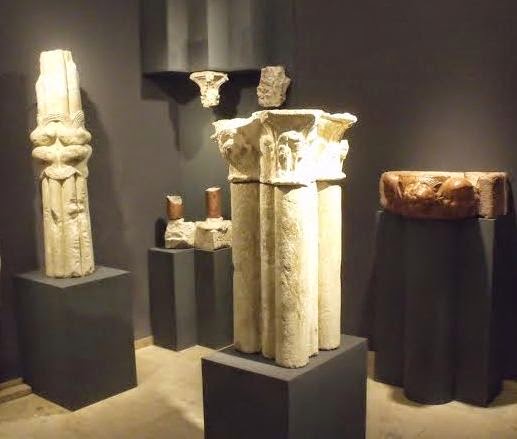The
Ferenczy Museum in Szentendre has recently moved into a new building in the center of the town, and this week an interesting temporary exhibition opened there. The focus of this exhibition is the royal Cistercian abbey of Pilis, as well as Queen Gertrude, wife of King Andrew II, who was buried there after she had been murdered 800 years ago. Stone carvings and archaeological finds from the monastery excavated at the site of the ruined monastery are preserved in the museum's collection.
The exhibition, titled „THE QUEEN TO KILL YOU MUST NOT FEAR WILL BE GOOD...“ Commemorate Gertrude of Merania, 1213-2013 is on view at the Barcsay Room of the Ferenczy Museum until December 31, 2013.
Dr. Judit Majorossy, the curator of the exhibition and Head of Research at the Ferenczy Museum provided the following text for the Medieval Hungary blog. This guest post is illustrated by photos of the exhibition, also provided by the museum.
"In the Middle Ages queens were particularly suitable for considering them as instigators of evil, not only due to their gender but also due to their often foreign origin. If there was discontent against the government, often not the kings were blamed but the bad consultants and, in this respect, queens were believed the most influential above all. In addition, if some queens exceeded their charity role by their husbands and behaved as active, strong women, they frequently became scapegoats. Most of the accusations of tyranny and nepotism can be attributed to their usurpation of male roles."
There were very few events in the course of medieval Hungarian history before the Mongol invasion (1241/1242) that triggered such a big stir in the contemporary European historiography as the murder of Gertrude of (Andechs-) Merania, the first wife of King Andrew II (1205–1235) from the Arpad dynasty. In the light of the present state of research the story of this infamous assassination seems to be clarified, but on the other hand, it is rather still complex.
Gertrude was killed on the 28th of September 1213 in an aristocratic conspiracy, after being the Queen of Hungary for ten years. She came to Hungary as a member of an ambitious Bavarian princely family. Behind the unpopularity of this dominant royal wife in Hungary one might suppose the political headway and influence of the German courtiers in her environment (the usual entourage of a foreign royal consort) that weakened the power of the domestic dignitaries. As a consequence, some noble Hungarians – Reeve Peter the son of Turoy, Simon of the Kacsics clan, and Simon of the Bar-Kalan clan, the son-in-law of the former palatine Banc ban – taking advantage of the ruler's absence being on a campaign in Halychya (the historical Galicia on the territory of present day Ukraine and Poland) and attacked the queen and her retinue supposedly in the royal Pilis forests during a festive hunting. Gertrude was brutally murdered, while her brother Berthold, archbishop of Kalocsa (1207–1218) and a special guest, Leopold VI, Duke of Austria (1198–1230) could hardly escape.

In the light of the contemporary sources, the real motives of this cruel act are unclear and contradictory. In addition, these motives were over-explained in the later Hungarian national history writing and romantic xenophobia. The accusation against Gertrude of helping the violation of Banc ban’s wife by her brother might be a few-decade later popular explanation of the events that was then carried on, while Gertrude’s responsibility for the inner courtly conflicts or the image of a weak-handed Andrew II must be re-evaluated and shaded.




.jpg)







.jpg)
.jpg)


















.jpg)








